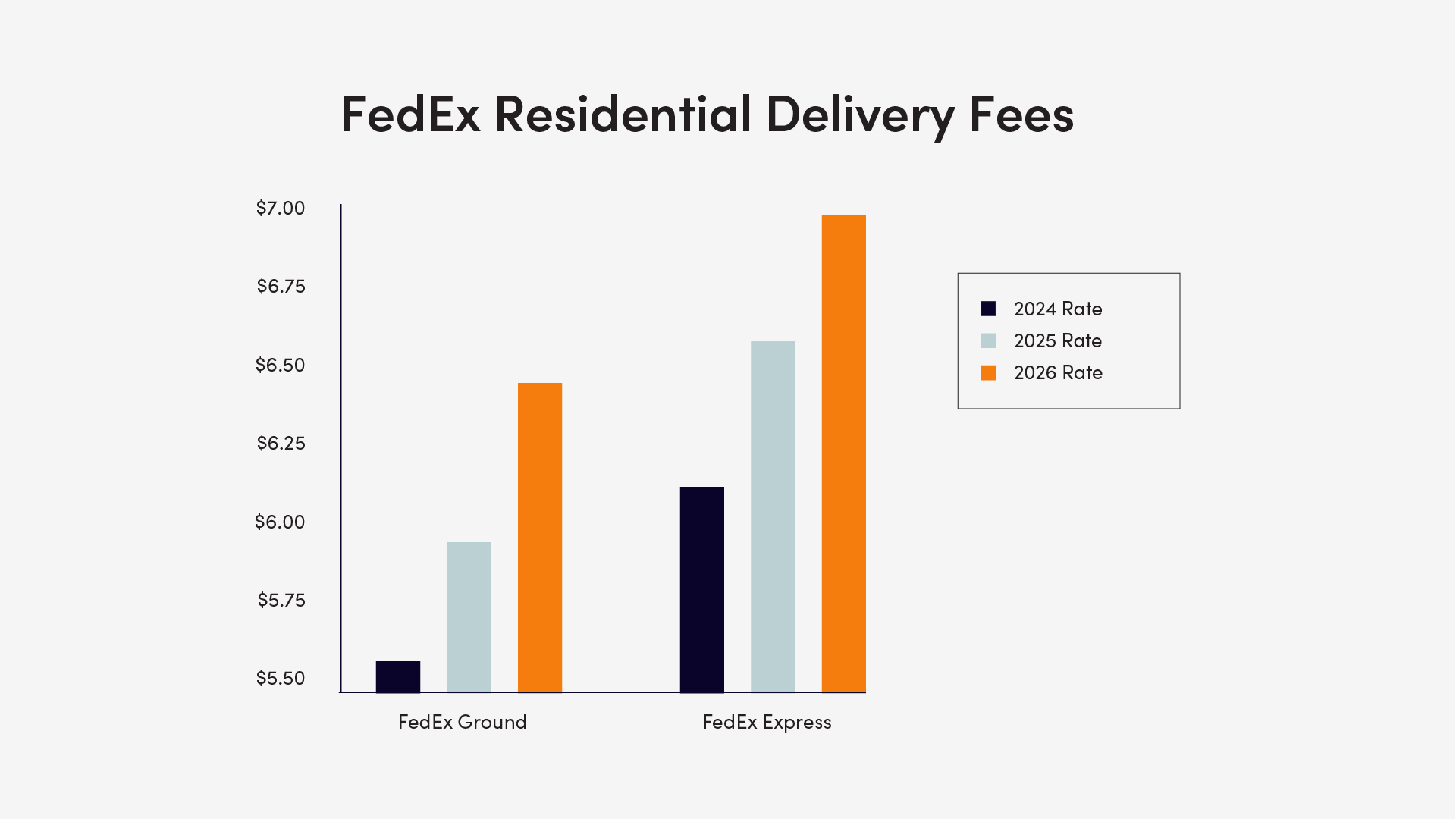For the third consecutive year, FedEx and UPS have announced a 5.9% average General Rate Increase (GRI). While the figure may seem familiar from years past, its real impact is much more complex, and understanding the nuances has become essential for protecting your bottom line.
GRIs are tools that help carriers balance network efficiency, cost, and customer behavior. Each year’s adjustments signal where operational pressures exist and where carriers aim to align pricing with cost-to-serve factors such as weight, distance, and delivery complexity.
It’s important to remember that the announced 5.9% headline is only an average. Some services will rise less, others more, and many will exceed this percentage by a significant margin. In reality, many shipments will see higher effective increases once surcharges, minimums, dimensional rules, and other adjustments are factored in.

Key Highlights:
| Surcharge | Average Increase % |
|---|---|
| Announced GRI | 5.9% |
| FedEx Residential Surcharge, Express | 6.1% |
| FedEx Residential Surcharge, Ground | 8.4% |
| FedEx Additional Handling | 5.6% |
| FedEx Oversize | 8.5% |
| UPS Residential Surcharge, Air | 6.9% |
| UPS Residential Surcharge, Ground | 6.6% |
| UPS Additional Handling | 6.9% |
| UPS Large Package Surcharge | 8.4% |
As you finalize budgets for the year ahead, it’s not enough to track the headline rate. A close, data-informed look at your unique shipping profile is crucial for accurate budgeting and cost control in 2026.
2026 FedEx GRI
FedEx’s 2026 GRI will go into effect on January 5, 2026.

Base Rate Increases
FedEx’s 2026 changes show stronger increases in longer-haul Zones 7 and 8, where higher operational costs and reduced competitive overlap create upward pricing pressure. Shorter-haul zones remain more stable, often reflecting regional carrier competition.
Weight is also a key variable. Packages in the 11–20 lb. range that are less contested by regional carriers experience slightly higher average increases, underscoring the value of reviewing packaging and weight strategies.
| Base + Rate Average Increase | Zone | % Increase by Weight | |||
|---|---|---|---|---|---|
| 1-5 LBS | 6-10 LBS | 11-20 LBS | 21+ LBS | ||
| FedEx Ground & FedEx Home Delivery | Zone 2 | 5.8% | 5.8% | 6.3% | 5.9% |
| Zone 5 | 5.5% | 5.5% | 6.5% | 5.9% | |
| Zone 7 | 5.9% | 5.9% | 6.7% | 6.2% | |
| Zone 8 | 5.9% | 5.9% | 6.7% | 6.1% | |
| FedEx Express Saver | Zone 2 | 3.9% | 3.9% | 3.9% | 3.9% |
| Zone 5 | 3.9% | 3.9% | 3.9% | 3.8% | |
| Zone 7 | 4.5% | 4.5% | 4.5% | 3.6% | |
| Zone 8 | 3.9% | 3.9% | 3.5% | 3.6% | |
| FedEx 2 Day | Zone 2 | 4.9% | 4.9% | 4.9% | 4.4% |
| Zone 5 | 7.3% | 6.5% | 6.5% | 6.8% | |
| Zone 7 | 6.8% | 6.5% | 6.9% | 6.5% | |
| Zone 8 | 6.8% | 6.5% | 6.7% | 6.8% | |
| FedEx 2 Day AM | Zone 2 | 5.2% | 5.2% | 5.2% | 5.1% |
| Zone 5 | 6.6% | 6.6% | 6.6% | 6.6% | |
| Zone 7 | 4.9% | 4.9% | 4.9% | 4.9% | |
| Zone 8 | 4.9% | 4.9% | 4.9% | 4.9% | |
| FedEx Priority Overnight | Zone 2 | 6.9% | 6.9% | 6.9% | 6.7% |
| Zone 5 | 6.5% | 6.5% | 6.5% | 6.5% | |
| Zone 7 | 6.5% | 6.5% | 6.5% | 6.5% | |
| Zone 8 | 6.5% | 6.5% | 6.5% | 6.6% | |
| FedEx Standard Overnight | Zone 2 | 5.9% | 5.9% | 4.9% | 4.8% |
| Zone 5 | 4.5% | 4.5% | 4.5% | 4.5% | |
| Zone 7 | 4.5% | 4.5% | 4.5% | 4.5% | |
| Zone 8 | 4.5% | 4.5% | 4.5% | 4.5% | |
For businesses operating from a single fulfillment center, these changes highlight the growing value of network decentralization. Distributing inventory across multiple locations can reduce reliance on long-haul zones, unlock regional carrier options, and mitigate the financial impact of base rate increases.
Minimum Charges
FedEx’s minimum Ground charge rises from $11.32 to $11.99, which is the lowest rate a shipment can be billed, regardless of negotiated discounts. Even if a shipper’s discounted rate falls below $11.99, the minimum still applies, reducing the value of negotiated discounts and potentially increasing overall shipping costs.
This change will impact shippers of lightweight, low-cost goods, as more of their packages will default to the minimum charge.
| FedEx Minimum Fees | 2025 Rate | 2026 Rate | 2025 - 2026 Increase |
|---|---|---|---|
| Priority Overnight | $42.31 | $45.22 | 6.9% |
| Standard Overnight | $38.55 | $40.82 | 5.9% |
| 2 Day | $25.23 | $26.46 | 4.9% |
| Express Saver | $22.95 | $23.84 | 3.9% |
| Ground / Home Delivery | $11.32 | $11.99 | 5.9% |
Accessorials
The most significant impacts of FedEx’s 2026 GRI are found in the details, particularly within accessorial fees. These charges are not included in the published 5.9% average increase, yet they play a central role in determining a shipper’s total transportation spend.
FedEx’s pricing structure continues to favor lightweight, small-cube packages, which are easier to handle, more profitable, and less likely to incur additional fees.
For shippers managing bulkier or more complex shipments, larger cost increases often result from accessorial surcharges rather than changes to the base rate.
Zone-Based Additional Handling & Oversize Surcharge
| FedEx Surcharge | 2024 Rate | 2025 Rate | 2025 Mid-Cycle Rate | 2025 Mid-Cycle Increase | 2026 Rate | 2025 - 2026 Increase |
|---|---|---|---|---|---|---|
| Additional Handling (Weight) | ||||||
| Zone 2 | $34.50 | $43.50 | $43.50 | - | $46 | 5.7% |
| Zone 3-4 | $37.50 | $47.50 | $47.50 | - | $50.25 | 5.8% |
| Zone 5-6 | $40 | $50.50 | $52.75 | 4.5% | $56.25 | 6.6% |
| Zone 7+ | $43.50 | $55 | $55 | - | $58.75 | 6.8% |
| Additional Handling (Dimension) | ||||||
| Zone 2 | $22 | $28 | $28 | - | $29.50 | 5.4% |
| Zone 3-4 | $24.50 | $31 | $31 | - | $32.75 | 5.6% |
| Zone 5-6 | $27 | $34 | $36 | 5.9% | $38.50 | 6.9% |
| Zone 7+ | $30 | $38 | $38 | - | $40.75 | 7.2% |
| Additional Handling (Packaging) | ||||||
| Zone 2 | $19.50 | $25 | $25 | - | $26.50 | 6.0% |
| Zone 3-4 | $23 | $29 | $29 | - | $30.75 | 6.0% |
| Zone 5-6 | $24 | $30.50 | $31 | 1.6% | $33 | 6.5% |
| Zone 7+ | $25 | $31.50 | $31.50 | - | $33.75 | 7.1% |
| Oversize (Express/Ground) | ||||||
| Zone 2 | $160 | $205 | $240 | 17.1% | $255 | 6.3% |
| Zone 3-4 | $175 | $225 | $260 | 15.6% | $275 | 5.8% |
| Zone 5-6 | $190 | $240 | $297.50 | 24% | $320 | 7.6% |
| Zone 7+ | $205 | $260 | $305 | 17.3% | $330 | 8.2% |
| Oversize (Home Delivery) | ||||||
| Zone 2 | $190 | $240 | $240 | - | $255 | 6.3% |
| Zone 3-4 | $205 | $260 | $260 | - | $275 | 5.8% |
| Zone 5-6 | $230 | $290 | $297.50 | 2.6% | $320 | 7.6% |
| Zone 7+ | $240 | $305 | $305 | - | $330 | 8.2% |
Curious how these increases play out in your shipping profile? Let’s walk through it together.

FedEx Residential Delivery Surcharge
Residential surcharges are increasing at a rate above inflation, highlighting the continued efforts to align pricing with the rising costs of last-mile delivery. The larger adjustment for Ground services (8.4%) reflects the growing importance of residential eCommerce shipments within the overall network. Express rates also remain higher on average, consistent with the service’s premium positioning and focus on time-definite delivery.
| FedEx Residential Delivery Fees | 2024 Rate | 2025 Rate | 2026 Rate | 2025 - 2026 Increase |
|---|---|---|---|---|
| FedEx Ground | $5.55 | $5.95 | $6.45 | 8.4% |
| FedEx Express | $6.15 | $6.55 | $6.95 | 6.1% |
FedEx Delivery Area Surcharge
Remote area deliveries experienced the largest increase (8.1%), reflecting the added complexity and cost of serving low-density regions.
| FedEx Delivery Area Fees | 2025 Rate | 2026 Rate | 2025 - 2026 Increase |
|---|---|---|---|
| Delivery Area Surcharge, Residential | $6.20 | $6.60 | 6.5% |
| Delivery Area Surcharge, Extended Residential | $8.30 | $8.80 | 6% |
| Delivery Area Surcharge, Commercial | $4.20 | $4.45 | 6% |
| Delivery Area Surcharge, Extended US Express Residential | $8.30 | $8.80 | 6% |
| Delivery Area Surcharge, Ground | $4.20 | $4.45 | 6% |
| Delivery Area Surcharge, Extended Ground | $5.25 | $5.55 | 5.7% |
| Delivery Area Surcharge, Remote Commercial, Remote | $15.50 | $16.75 | 8.1% |
Required Signature Increase
FedEx announced updates to its Signature Required service fees, with the most notable change a 15.6% increase for Adult Signature Required. This service confirms delivery to a verified recipient aged 21 or older.
| FedEx Required Signature Fees | 2025 Rate | 2026 Rate | 2025 - 2026 Increase |
|---|---|---|---|
| Adult Signature Required | $8.65 | $10 | 15.6% |
| Direct Signature Required | $7.15 | $7.60 | 6.3% |
| Indirect Signature Required | $7.15 | $7.60 | 6.3% |
The change reflects the higher labor and security involved in verified deliveries, especially for age-restricted or high-value items. As online sales continue to expand, signature confirmation remains a key safeguard for compliance and customer trust.
2026 UPS GRI
More than a month after FedEx announced its GRI (effective January 5, 2026), UPS announced its own 5.9% GRI, effective December 22, 2025.

Base Rate Increases
UPS is implementing notable base rate increases across all major service levels, with lighter-weight and long-distance shipments seeing the highest growth. These adjustments continue the carrier’s trend toward aligning prices with cost-to-serve factors such as speed, distance, and delivery difficulty.
While the announced average increase across UPS’s services typically hovers around the mid–single digits, the actual impact for shippers varies based on zone, weight, and service type.
- Packages between 1–5 lbs are most affected, with increases frequently above 6%.
- Longer-distance zones (7–8) and air shipments see higher adjustments than short-haul ground deliveries.
- Fast or specialized services, like Next Day Air A.M., carry greater premiums, reflecting their higher operational complexity.
| Base + Rate Average Increase | Zone | % Increase by Weight | |||
|---|---|---|---|---|---|
| 1-5 LBS | 6-10 LBS | 11-20 LBS | 21+ LBS | ||
| UPS Ground | Zone 2 | 6.0% | 5.5% | 6.1% | 5.8% |
| Zone 5 | 5.9% | 5.5% | 6.5% | 6.0% | |
| Zone 7 | 6.0% | 5.7% | 6.7% | 6.2% | |
| Zone 8 | 6.0% | 5.9% | 6.5% | 6.2% | |
| UPS Next Day Air A.M. | Zone 2 | 4.2% | 4.5% | 5.0% | 5.9% |
| Zone 5 | 5.3% | 5.4% | 6.1% | 6.3% | |
| Zone 7 | 5.8% | 5.5% | 6.4% | 6.3% | |
| Zone 8 | 5.6% | 5.6% | 6.1% | 6.5% | |
| UPS Next Day Air | Zone 2 | 6.6% | 6.7% | 6.8% | 6.4% |
| Zone 5 | 6.2% | 5.3% | 5.7% | 5.6% | |
| Zone 7 | 6.2% | 5.2% | 5.7% | 6.1% | |
| Zone 8 | 6.2% | 5.2% | 5.7% | 6.5% | |
| UPS Next Day Air Saver | Zone 2 | 6.5% | 4.5% | 5.5% | 5.3% |
| Zone 5 | 6.5% | 4.5% | 5.5% | 5.3% | |
| Zone 7 | 6.5% | 4.5% | 5.5% | 5.3% | |
| Zone 8 | 6.5% | 5.2% | 5.7% | 5.6% | |
| UPS 2nd Day Air A.M. | Zone 2 | 5.2% | 5.2% | 5.2% | 5.1% |
| Zone 5 | 6.6% | 6.6% | 6.6% | 6.5% | |
| Zone 7 | 5.4% | 4.9% | 5.6% | 5.0% | |
| Zone 8 | 5.4% | 4.9% | 5.7% | 4.8% | |
| UPS 2nd Day Air | Zone 2 | 6.5% | 4.9% | 5.7% | 4.9% |
| Zone 5 | 7.1% | 6.5% | 6.5% | 6.8% | |
| Zone 7 | 6.8% | 6.2% | 6.3% | 6.2% | |
| Zone 8 | 6.7% | 6.0% | 6.1% | 6.1% | |
Accessorials
UPS’s 2026 accessorial rates reflect average increases of 6–10% across many categories, particularly for heavier or larger parcels that require extra handling.
The overall trend points to continued cost escalation for shipments that exceed standard dimensions or packaging guidelines.
| UPS Surcharge | 2024 Rate | 2025 Rate | 2025 Mid-Cycle Rate | 2025 Mid-Cycle Increase | 2026 Rate | 2025 - 2026 Increase |
|---|---|---|---|---|---|---|
| Additional Handling (Weight) | ||||||
| Zone 2 | $34.50 | $43.50 | $43.50 | - | $46.50 | 6.9% |
| Zone 3-4 | $37.50 | $47.50 | $47.50 | - | $50.75 | 6.8% |
| Zone 5-6 | $41.50 | $52.75 | $52.75 | - | $56.25 | 6.6% |
| Zone 7+ | $41.50 | $52.75 | $55 | 4.3% | $58.75 | 6.8% |
| Additional Handling (Dimension) | ||||||
| Zone 2 | $22 | $28 | $28 | - | $30 | 7.1% |
| Zone 3-4 | $24.50 | $31 | $31 | - | $33.25 | 7.3% |
| Zone 5-6 | $28.25 | $36 | $36 | - | $38.50 | 6.9% |
| Zone 7+ | $28.25 | $36 | $38 | 5.6% | $40.50 | 6.6% |
| Additional Handling (Packaging) | ||||||
| Zone 2 | $19.50 | $25 | $25 | - | $26.75 | 7.0% |
| Zone 3-4 | $23 | $29 | $29 | - | $31 | 6.9% |
| Zone 5-6 | $24.50 | $31 | $31 | - | $33.25 | 7.3% |
| Zone 7+ | $24.50 | $31 | $31.50 | 1.6% | $33.75 | 7.1% |
| Large Package (Commercial) | ||||||
| Zone 2 | $160 | $205 | $205 | - | $219.50 | 7.1% |
| Zone 3-4 | $175 | $225 | $225 | - | $239.50 | 6.4% |
| Zone 5-6 | $197.50 | $250 | $250 | - | $273 | 9.2% |
| Zone 7+ | $205 | $250 | $260 | 4% | $286 | 10% |
| Large Package (Residential) | ||||||
| Zone 2 | $190 | $240 | $240 | - | $254.50 | 6% |
| Zone 3-4 | $205 | $260 | $260 | - | $274 | 5.6% |
| Zone 5-6 | $235 | $297.50 | $297.50 | - | $320.50 | 7.7% |
| Zone 7+ | $297.50 | $297.50 | $305 | 2.5% | $331 | 8.5% |
UPS’s 2026 delivery surcharge updates are part of a broader trend toward cost alignment with delivery efficiency. While the increases may seem modest per package, the cumulative effect across residential and remote deliveries can be substantial.
UPS Residential Delivery Surcharge
| UPS Residential Surcharge | 2024 Rate | 2025 Rate | 2026 Rate | 2025 - 2026 Increase |
|---|---|---|---|---|
| Ground | $5.65 | $6.10 | $6.50 | 6.6% |
| Air | $6.20 | $6.55 | $7 | 6.9% |
UPS Delivery Area Surcharge
| UPS Delivery Area Surcharges | 2024 Rate | 2025 Rate | 2026 Rate | 2025-2026 Increase |
|---|---|---|---|---|
| UPS Ground (Commercial) | $3.95 | $4.20 | $4.50 | 7.1% |
| UPS Ground (Residential) | $5.85 | $6.15 | $6.55 | 6.5% |
| UPS Air (Commercial) | $3.95 | $4.20 | $4.50 | 7.1% |
| UPS Air (Residential) | $5.70 | $6.15 | $6.55 | 6.5% |
Adding to the complexity, UPS plans to update the ZIP codes subject to these surcharges starting December 22, 2025, along with adjustments to the zone alignment list. These changes could expand the number of addresses that incur delivery area fees, even if base rates remain the same.
Additional Considerations
Mid-Cycle Rate Increases
In 2025, both carriers introduced more than a dozen mid-cycle increases. The pattern suggests that annual GRIs are now just one piece of a rolling pricing strategy. Shippers should plan for periodic accessorial and rule updates throughout the year.
New Cubic Volume Rules
Both carriers are also shifting from the traditional “length + girth” system to new cubic volume thresholds for determining Additional Handling Charges or Large Package/Oversize Surcharges. Effective January 12, 2026, for FedEx, and January 26, 2026, for UPS.
Fees are now triggered not just by length, but by the overall volume of the package (e.g., cubic volume greater than 10,368 cubic inches for Additional Handling, and 17,280 cubic inches for Oversize).
The shift emphasizes the importance of cubic volume (a package’s overall shape and space consumption) rather than just its length or girth. As a result, shippers handling large, lightweight, or bulky items that occupy significant space despite lower weight will be most affected by these updates.
Added Fuel Surcharges
Fuel-related fees are being integrated into a wider range of accessorials per FedEx and UPS. Traditionally, these surcharges were limited to transportation-related accessorial fees such as Delivery Area Surcharge (DAS), Residential Delivery (RES), and Oversize Package fees. However, in recent years, the scope has broadened to include additional service charges like Address Correction and Additional Handling.
This expansion reflects a shift in how fuel costs are integrated into the overall pricing structure. Because fuel surcharges are layered on top of other accessorial fees, they can contribute to a higher total shipping cost than anticipated.
Building Your 2026 Shipping Strategy
Step #1: Understand How the General Rate Increase Impacts You
FedEx’s 2026 General Rate Increase (GRI) averages 5.9%, but that figure is just a baseline. It represents an average across base transportation rates, not the full picture of how costs will shift for individual shippers. Relying solely on the 5.9% figure for budgeting will lead to inaccurate forecasts. To plan effectively, businesses need to analyze how the rate changes interact with their unique shipping profiles.
A smart starting point is to compare your current landed cost—the total expense to produce, ship, and deliver a product—to your cost structure after the 2026 GRI. This will help identify where increases are most likely to occur.
Key metrics to evaluate include:
- Average zone
- Average price/pack
- Total accessorial charges
- Shipping charges by service type
- Spend trends
- Carrier agreement terms and discounts
Accessorial charges, in particular, can drive up costs quickly. For example, shipping a 1 lb. Ground package with FedEx in 2026 may include:
- A residential surcharge (up 8.4%)
- A dimensional weight charge (which may exceed the actual weight charge)
- A delivery area surcharge (up 6.5%)
Carriers closely monitor these metrics and use them to inform pricing strategies. Understanding how your shipping behavior aligns with carrier priorities can help you make adjustments that reduce costs and improve efficiency.
For businesses short on time or resources, SiftedAI can help model these changes and provide actionable insights tailored to your shipping data.
Step #2: Develop a Plan to Reduce Cost Impact
As carriers continue to refine their pricing models, shippers can take proactive steps to manage costs and maintain efficiency.
Collaborate with Your Carrier
Rather than viewing your carrier as a competitor, consider them a strategic partner. Engage with your carrier representative to explore ways to streamline operations. By aligning your shipping practices with their efficiency goals, you may uncover opportunities for mutual benefit, such as improved service levels or more favorable pricing.
Use the insights from Step #1 to pinpoint where GRI will have the greatest impact on your business. Then leverage that data in discussions to negotiate terms that better reflect your shipping volume and patterns.
Review Your Agreement Closely
Carrier agreements often contain clauses that can influence your overall spend. Look for:
- Minimum spend requirements that may offset negotiated discounts
- Surcharges tied to package dimensions, delivery zones, or service types
- Terms that may be renegotiated based on updated shipping behavior
Understanding these details can help you avoid unexpected fees and ensure your discounts deliver real value.
Explore Internal Adjustments
To further mitigate rising costs, consider operational changes such as:
- Passing incremental shipping costs to customers where appropriate
- Offering slower, more economical shipping options
- Diversifying your carrier mix by including regional providers
- Optimizing packaging to reduce dimensional weight charges
- Implementing zone skipping or enhancing in-region fulfillment strategies
Each of these tactics can help offset surcharges and improve cost efficiency without compromising customer experience.
Step 3: Leverage SiftedAI for Smarter Shipping Decisions
Navigating the impact of GRIs requires more than just reactive budgeting; it calls for a data-driven strategy. Success comes not only from understanding the changes but also from having the right tools and trusted partners to respond effectively.
With SiftedAI, shippers gain access to a powerful suite of solutions that deliver clarity, precision, and actionable insights—enabling you to stay ahead of market shifts with confidence.
Visualize the Impact
SiftedAI’s dedicated GRI Dashboard allows you to see exactly how rate increases affect your shipping profile. By analyzing your historical data and current patterns, you can identify where costs are rising and why.
Model Strategic Scenarios
With Sifted’s decision support tools, you can run advanced simulations to uncover opportunities for cost savings and operational improvements. These insights can help you determine when to:
- Eliminate unnecessary spend by flagging avoidable charges and inefficiencies
- Open new distribution centers to optimize origin points and reduce zone-based surcharges
- Diversify your carrier mix by incorporating regional or LTL carriers, or exploring alternatives like USPS Ground Advantage and Amazon Shipping
- Re-evaluate packaging strategies to minimize dimensional weight and oversize fees
Stay Ahead of the Curve
GRIs can introduce unexpected cost pressures, but with the right tools, you can stay ahead of the competition.
SiftedAI empowers you to make informed decisions, reduce spend, and adapt your logistics strategy with precision.












